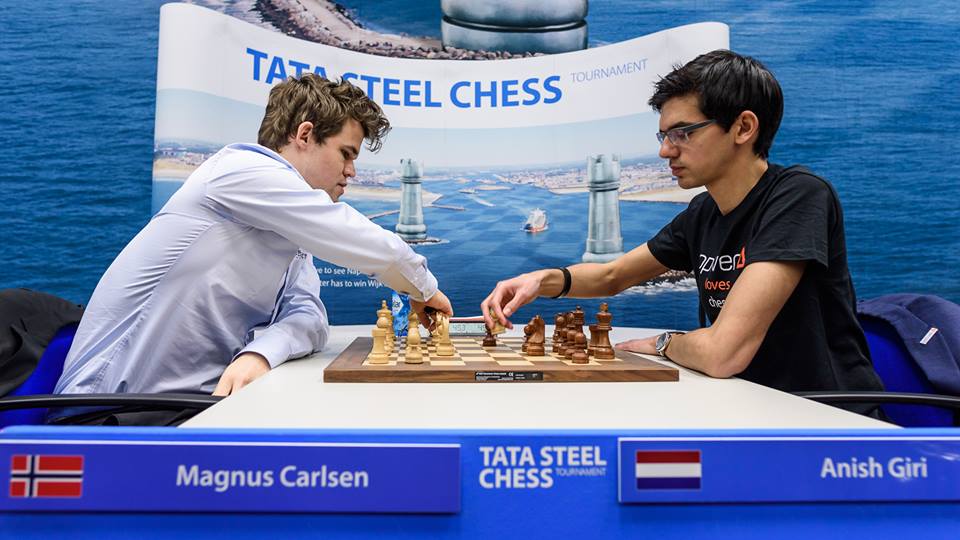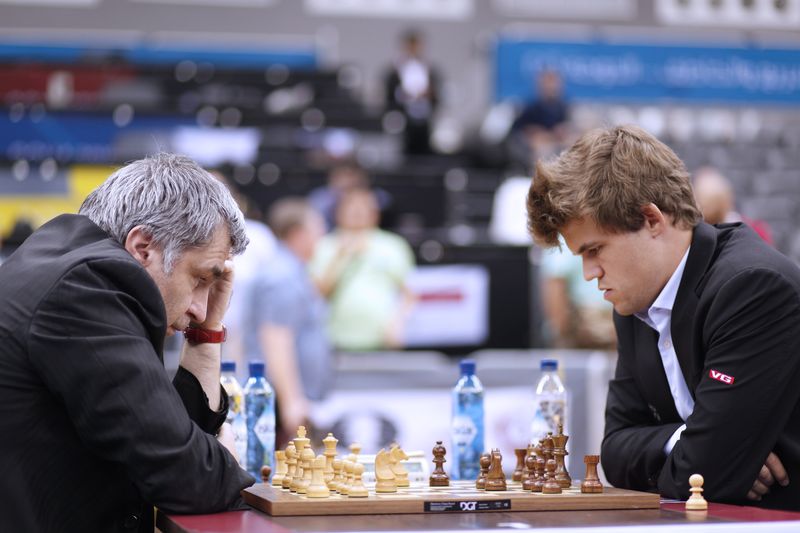CBM 201: Carlsen under pressure - a review by Nagesh Havanur
Even as I write these lines, Magnus Carlsen has won the FTX Crypto Chess Cup beating Wesley So in an armageddon tie-break. This was a powerful contest with Carlsen facing his forthcoming world championship challenger, Ian Nepomniachtchi and rivals, Anish Giri, Hikaru Nakamura, Wesley So and Daniil Dubov among others. Carlsen struggled with his form throughout as Mark Crowther put it in his TWIC report on this competition. What is clear is that Carlsen’s opponents have closed in on him over the last 12 months. This issue includes games from two major events, the Carlsen Invitational and Opera Europe Rapid Tournaments in which Magnus played and allowed himself to be outpaced by others.
Anish Giri prevails

Wijk aan Zee 2018, good old days when they met face to face | Photo: Alina l'Ami
The first, Carlsen Invitational had a star-studded field led by Magnus himself followed by Wesley So, Anish Giri and Ian Nepomniachtchi among others. As it turned out, it was Anish Giri who overcame resistance from every one else. In this issue he has annotated quite a few games from the event including his encounters with Carlsen and Nepomniachtchi.
Here is the game with Carlsen with a deep personal commentary by the winner.
Anish Giri- Magnus Carlsen, Carlsen Invitational 2021
Magnus misses again

Wesley So beating Magnus Carlsen in Fischer Random Championship 2019 | Photo: Lennart Ootes
The second event, Opera Euro Rapid was arguably more exciting than the first. Here it was Wesley So who prevailed over the rest to meet Carlsen in a mini-match. The world champion missed more than one opportunity to level scores and move ahead. But this did not happen. A case in point is the following position. Here Carlsen only played the relatively "safe" 16…exd4 and drew. Was there a win? Your turn.
Black to play
In fairness to Wesley So, he did outplay Carlsen with White and won, a game that he annotated in a recent issue of New in Chess Magazine. But it was the last game of this mini-match that turned out to be more exciting. Carlsen played the opening with finesse and with Wesley So taking unreasonable risks, should have prevailed in the middlegame. Then the tide began to turn. Here is what happened:
Magnus Carlsen-Wesley So, Opera Euro Rapid 2021
An uphill battle in which the outcome is far from clear even on the last move!
After the knockout match Wesley So was modest about his victory and sincerely thanked Carlsen for giving an opportunity to play in the series. He also made amends for "celebrating" his victory on camera.
Vassily Ivanchuk, the Ukranian maverick

Vassily Ivanchuk vs Magnus Carlsen | Photo Courtesy: ChessPro.ru
The Special Section includes a tribute to Vassily Ivanchuk with 22 annotated games. His victims here include Kasparov, Anand and Shirov among others. This is a small sample offering a glimpse of his play. The MegaBase alone has more than 4000 games.
Our Gen.Next may wonder who is this grandmaster and what is special about him. One word would describe him best. He is unpredictable. You never know what happens when he plays. Ask Carlsen and Kramnik who have been at the receiving end of his play. "Then why didn’t he become world champion?" young readers may ask.
The Ukranian maverick is a man with a volatile temperament and a bundle of nerves in fatal moments. Judit Polgar also pointed out another strange trait, immersed in deep thoughts, he would overlook simple moves, allowing his opponent to escape.
He is a man of moods. On occasion he would play strange moves and when they don’t work, suffer a terrible defeat. Or else he would play listlessly and lose. No one suffers as much as he does when this happens.
Linares 1991: His finest hour
It was all so different when he was young and he wouldn’t put a foot wrong when he was inspired. Old timers still remember his visit to Linares in 1991. Everything about it was "crazy". He had arrived in the city at 5 o’clock in the morning just ten hours before the first round. It was a long and tiring journey riddled with hold-ups and delays. When he made enquiries at Hotel Anibal, the tournament venue, he was informed, he had to play Kasparov, the world champion in the afternoon. Garry was at the height of form, having beaten Karpov in a world champion the year before. Anatoly still smarting under that defeat was here to play and show every one what he was capable of. The other players included veterans, Beliavsky, Yusupov and Timman, young hopefuls, Anand, Speelman and Gelfand. Then an extraordinary drama unfolded. Our young hero disposed of both Kasparov & Karpov not to mention his own peers, Anand and Gelfand to come first with 9½ out of 13 points (+6, =7 -0).

The 21-year-old Vassily Ivanchuk, pictured after winning Linares 1991 Tournament Credit: unknown.) | Photo Courtesy: Douglas Griffin’s blog on Soviet Chess History
He was barely 21 at the time. How had he prepared for the tournament? With his wife, Alisa Galliamova, a strong female chess player at the time. They had just married and she was his talisman, so to speak.
This issue highlights both Ivanchuk’s games and that famous Linares Tournament 1991.
Mihal Marin has chosen 16 games from Linares 1991 for his question and answer session on strategy.
During 1990s Linares was known as the Wimbledon of chess. It was here that young stars, Anand, Ivanchuk Kramnik and Shirov challenged the dominance of Karpov and Kasparov. Veteran chess journalist, Dirk Jan ten Geuzendam wrote a whole book, recreating the atmosphere and ambience of the tournament.

Here is a fascinating passage on Ivanchuk from the book:
Ivanchuk's victories have earned him an unbelievable popularity with the Linarese. People greet him everywhere with a brief and warm 'Ivanchuk!' The warmth they feel at his unaffected behaviour outweighs their admiration for the distant Kasparov. Ivanchuk doesn't push his way haughtily through the crowd of noisy children thronging at the bottom of the hotel stairs every day begging the players for a signature in their programme booklets. He always stops to sign a few. In the year of his third tournament victory, he invited these young admirers to join him in eating the cake that the restaurant kitchen had prepared for him.
(Linares! Linares: A journey into the heart of chess)
Opening videos and surveys
There are 3 opening videos by Mihail Marin, Rustam Kasimdzhanov and Jan Werle (they are featured on the cover of this issue).
The first by Mihail Marin deals with Mikanes System of the English opening (A19). This is an obscure line, rarely seen.
The second by Kasimdzhanov deals with an important line, 11…Ne7 in Sicilian Sveshnikov (B33).
The third by Jan Werle deals with 4.f3, the Sämish Variation of the Nimzo-indian (B25).
This should be studied along with an opening survey on the same line by Evgeny postny in this issue.
Incidentally, there are as many as 12 opening surveys ranging from the Sicilian to the Semi-Slav in this issue. For now I would like to single out the surveys on the Belgrade Gambit (C47) and Sicilian Grand Prix Attack (B23) for special mention.
Besides opening surveys, this issue has standard features on tactics, strategy and the endgame.
Summing up
The main database of the issue has 547 recent games of which 32 are deeply annotated.
Commentators include Anish Giri, Wesley So and Jan Duda among others. Major contributions are made by Michal Krasenkow (8 games) and Romain Edouard (14 games)
It may be noted that there are more annotated games in the sections on opening theory and training. Well, practice makes perfect.
Note: More info on the early career of Ivanchuk may be found in Douglas Griffin’s chess blog
There are two collections of Ivanchuk’s games in English.
1)Vassily Ivanchuk: 100 Selected Games by Nikolai Kalinichenko (New in Chess 2013).
2)Ivanchuk, Move by Move by Junior Tay (Everyman Chess, 2015)
Buy ChessBase Magazine #201 in the ChessBase shop...




























